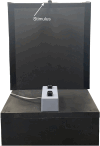Grasping tiny objects
- PMID: 38554146
- PMCID: PMC11281983
- DOI: 10.1007/s00426-024-01947-8
Grasping tiny objects
Abstract
In grasping studies, maximum grip aperture (MGA) is commonly used as an indicator of the object size representation within the visuomotor system. However, a number of additional factors, such as movement safety, comfort, and efficiency, might affect the scaling of MGA with object size and potentially mask perceptual effects on actions. While unimanual grasping has been investigated for a wide range of object sizes, so far very small objects (<5 mm) have not been included. Investigating grasping of these tiny objects is particularly interesting because it allows us to evaluate the three most prominent explanatory accounts of grasping (the perception-action model, the digits-in-space hypothesis, and the biomechanical account) by comparing the predictions that they make for these small objects. In the first experiment, participants ( ) grasped and manually estimated the height of square cuboids with heights from 0.5 to 5 mm. In the second experiment, a different sample of participants ( ) performed the same tasks with square cuboids with heights from 5 to 20 mm. We determined MGAs, manual estimation apertures (MEA), and the corresponding just-noticeable differences (JND). In both experiments, MEAs scaled with object height and adhered to Weber's law. MGAs for grasping scaled with object height in the second experiment but not consistently in the first experiment. JNDs for grasping never scaled with object height. We argue that the digits-in-space hypothesis provides the most plausible account of the data. Furthermore, the findings highlight that the reliability of MGA as an indicator of object size is strongly task-dependent.
© 2024. The Author(s).
Conflict of interest statement
The authors have no Conflict of interest as defined by Springer, or other interests that might be perceived to influence the results and/or discussion reported in this paper.
Figures





Similar articles
-
Obeying the law: speed-precision tradeoffs and the adherence to Weber's law in 2D grasping.Exp Brain Res. 2019 Aug;237(8):2011-2021. doi: 10.1007/s00221-019-05572-5. Epub 2019 Jun 3. Exp Brain Res. 2019. PMID: 31161415
-
Hand anthropometry and the limits of aperture separation determine the utility of Weber's law in grasping and manual estimation.Exp Brain Res. 2018 Aug;236(8):2439-2446. doi: 10.1007/s00221-018-5311-6. Epub 2018 Jun 19. Exp Brain Res. 2018. PMID: 29923096
-
Visually and memory-guided grasping: aperture shaping exhibits a time-dependent scaling to Weber's law.Vision Res. 2011 Sep 1;51(17):1941-8. doi: 10.1016/j.visres.2011.07.005. Epub 2011 Jul 14. Vision Res. 2011. PMID: 21777599
-
Biomechanical constraints do not influence pantomime-grasping adherence to Weber's law: A reply to Utz et al. (2015).Vision Res. 2017 Jan;130:31-35. doi: 10.1016/j.visres.2016.09.018. Epub 2016 Nov 29. Vision Res. 2017. PMID: 27876512
-
Independent control of the digits predicts an apparent hierarchy of visuomotor channels in grasping.Behav Brain Res. 2002 Nov 15;136(2):427-32. doi: 10.1016/s0166-4328(02)00189-4. Behav Brain Res. 2002. PMID: 12429404 Review.
Cited by
-
The "What" and "How" of Pantomime Actions.Vision (Basel). 2024 Sep 26;8(4):58. doi: 10.3390/vision8040058. Vision (Basel). 2024. PMID: 39449391 Free PMC article. Review.
References
-
- Bruno, N., Uccelli, S., Viviani, E., & de’Sperati, C. (2016). Both vision-for-perception and vision-for-action follow Weber’s law at small object sizes, but violate it at larger sizes. Neuropsychologia,91, 327–334. 10.1016/j.neuropsychologia.2016.08.022 10.1016/j.neuropsychologia.2016.08.022 - DOI - PubMed
MeSH terms
LinkOut - more resources
Full Text Sources

